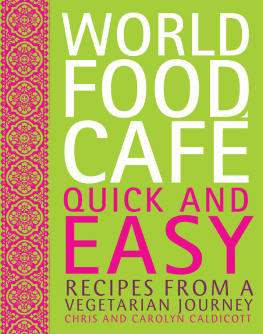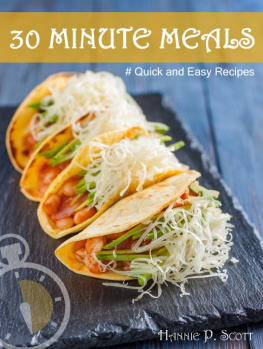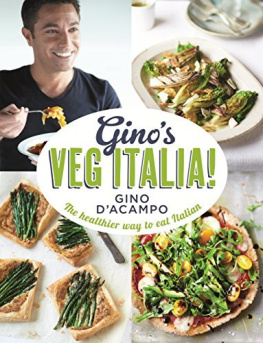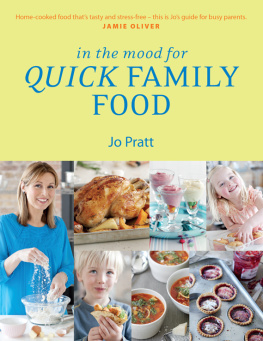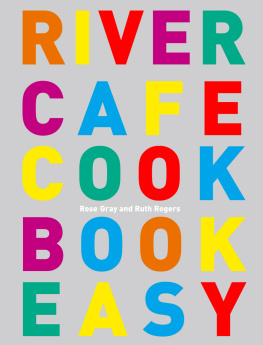World Food Caf
Quick & Easy
Recipes from a Vegetarian Journey
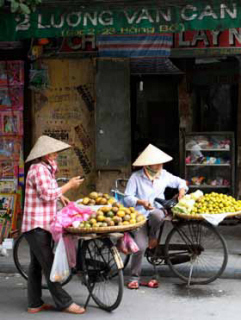
Contents
INTRODUCTION
This, our third World Food Caf book, is a brand-new collection of quick and easy to cook vegetarian recipes we have collected on recent journeys to some of the most exciting travel destinations in the world. Most were to countries we had never been to before, where we discovered completely new tastes and styles of cuisine. Others were to countries we had not been to for many years, where we wanted to explore new areas in search of dishes we had not tried before. This is vegetarian cooking at its most delicious and imaginative. Yet even the most exotic-sounding recipes are for everyday dishes in the countries where we found them.
Regardless of how we travelled, we needed to eat on the hoof, sometimes using just what we could carry and had to cook on. Some recipes come from the home kitchens of people we met along the way; some were gleaned from ships galleys, roadside cafs or riverside stalls; others were cooked for us in places as diverse as tents on remote mountainsides, restaurants in busy cities and pop-up kitchens at special events.
Our journey up the Irrawaddy River in upper Burma was on a converted Rhine river cruiser. In Bangladesh we navigated the Ganges Delta on an antique flat-bottomed paddle steamer. We followed the Mekong along the whole length of Laos by a combination of local boats, ferries and long drives. In Chile we combined driving with walking to cross the Andes into Argentina. On our trek to the Tigers Nest Monastery in Bhutan walking was the only option, much of it through fresh snow. In Namibia the distances were so great that we had to use light aircraft to travel up the roadless Skeleton Coast. Driving in an open-top 1950s convertible was pure joy along the empty roads of Cuba. Our other great road trip was across Syria from the ancient city of Damascus to the even older remains of Palmyra. In Japan the fastest and most comfortable trains in the world made it possible to cover vast distances with ease, in contrast to the Reunification Express that took us so slowly along the coast of Vietnam. The slowest journey of all was following the herds of reindeer being rounded up for the winter by the semi-nomadic Sami people we spent time with in Lapland.
ALL RECIPES ARE FOR FOUR GREEDY OR SIX MODEST PORTIONS, UNLESS OTHERWISE STATED.
Bangladesh
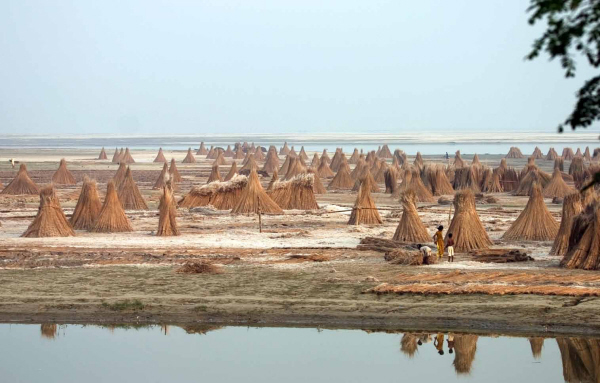
NOT SO SLOWLY DOWN THE GANGES BY PADDLE STEAMER
S tanding on the upper deck of the PS (passenger steamer) Mahsud, we watched a determined sun fight its way through a cauldron of monsoon clouds and swirling river mist. Sharp rays of orange light searched out the tiny canoes of fishermen lost in the immensity of the river. On the bank silhouetted palm trees towered above villages of thatched adobe houses. Wood smoke from a hundred breakfast kitchen fires mingled with the mist. Women as brown as the bank where they knelt down to gather water bore the water away in clay pots balanced on their heads with a straight-backed grace and rhythmic swagger worthy of catwalk models.
The boat ploughed its way on through the reluctant dawn down the sluggish soupy water of the Ganges Delta. It was a scene so loaded with atmospheric drama it could have been created by special effects on a film set of a river journey into some kind of subcontinental heart of darkness.
The Mahsud is one of a fleet of flat-bottomed paddle steamers known as the Rockets that still ply the waterways of Bangladesh daily between the capital, Dhaka, and Mongla, the gateway to the Sunderbans National Park.
Our journey had begun at sunset the night before among the epic chaos of Sadarghat, the main passenger boat terminal in the heart of Old Dhaka on the Buriganga River. Once darkness fell, we asked if we could go down below and see the on-board kitchens prepare the evening meal. In the furnace heat of the galley, deep in the bowels of the ship, some jolly cooks showed us how to make sukto (a yellow vegetable curry), fulkopi (cauliflower) with nuts and raisins and a fabulous fresh green pea dhal.
Soon after dawn we reached the fishing harbour of Barisal, busy with men delivering giant blocks of ice to the massed fishing boats. For the rest of the day we navigated the worlds largest estuarine delta to a backdrop of pancake-flat paddy fields, tracts of thick lush jungle, villages on stilts, fishing nets, fishing boats, lines of hand-thrown pots drying in neat lines on the shore, farm animals and people. Always there were people, never a moment without them, busy people but never too busy to smile at strangers. In Mongla we boarded a smaller boat and set sail for the Sunderbans.
FOOD IN BANGLADESH
The popular saying Bangladeshis live to eat perfectly sums up the attitude to food here, from the important daily early morning task of shopping for the freshest possible ingredients to the fine art of delicate spicing handed down through the generations. There is no doubt that Bangladeshis love their food.
At mealtimes flavours are savoured. Piling everything on to one plate at the same time is considered a crime to the tastebuds, and each dish is served as a separate course, with a definite pecking order in the way they are served. Bittersweet shukto, made with karela bitter gourds, usually kicks off the proceedings, as it is considered to have cleansing properties. A dhal of split or whole pulses follows, and then maybe a simple vegetable chaat, followed by a poppy-seed posto. Bangladeshis love fish but they are also very partial to vegetables. A spiced, tart, fruit tuk is served to cleanse the palate before the main event, pudding: milky, sweet, cardamom-spiced desserts are a speciality and it is inconceivable to end a meal without one, even if it is just a simple caramel-sweetened home-made yoghurt.
Panch phoron or Bengali five-spice a mixture of cumin, fennel, fenugreek, mustard and black onion seeds adds distinctive spicing unique to the region, with ground mustard seeds adding pungency. Ground spices are often blended with water before being fried in hot oil; mustard oil is the preferred cooking oil, although ghee is essential in recipes from Bangladeshs Moghul past. Ground coconut, poppy seeds, sesame seeds, dried fruit and nuts are combined to make creamy, fragrant curries, which are served alongside complex rice biryanis. If you are in hurry, there is always an inventive dhal to be had, served with crispy luchi (fried unleavened bread) and a garlicky mustard dip.
One thing for sure is that nothing goes to waste. The Bangladeshis have made an art out of using every bit of the humble vegetable, with recipes that transform vegetable peelings, roots and stalks into a delicious memorable meal.
FRESH MINT AND YOGHURT BORHANI
In the simmering afternoon heat tiffin was served up on deck. We sipped this cooling minty yoghurt drink as we watched the day-to-day riverside life pass us by.
teaspoon cracked black pepper
teaspoon ground cumin
480ml/16fl oz full-fat thick yoghurt
large handful of fresh mint leaves, plus some to garnish
heaped teaspoon brown sugar
pinch of salt
2 green chillies, sliced, plus some to garnish
Toast the black pepper and cumin in a small frying pan.
Blend with the remaining ingredients in a liquidizer with 240ml/8fl oz cold water until the mint leaves are finely chopped. Pour into tall glasses, and garnish with more mint leaves and a little thinly sliced green chilli.
Next page
